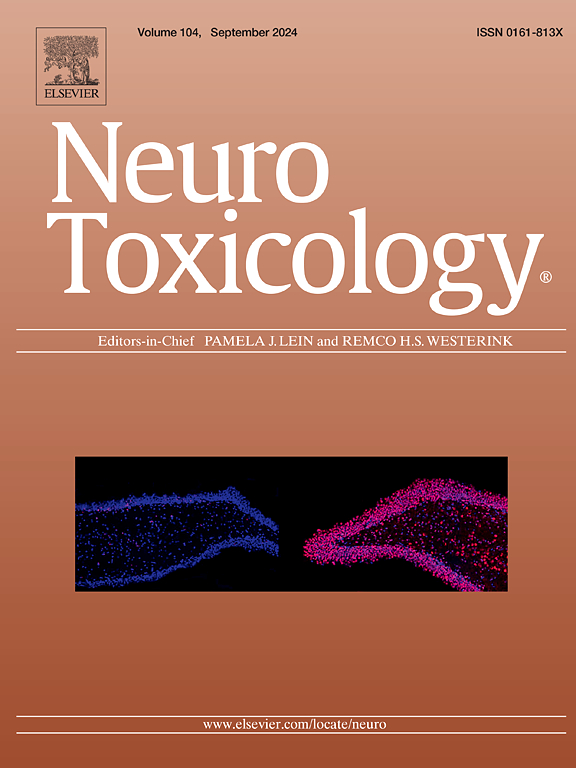青少年早期铅暴露对脑功能和反应的影响:来自中国队列的研究结果
IF 3.9
3区 医学
Q2 NEUROSCIENCES
引用次数: 0
摘要
虽然铅暴露对认知的有害影响已被充分记录,但对青春期前人群的研究较少。本研究的目的是了解青少年铅暴露与脑功能测量之间的关系。方法在中国早期青少年队列中(N = 258人(50.1% %女性),平均年龄11.51岁),我们研究了三种类型刺激在听觉古怪任务中引发的血铅水平(BLLs)与P300事件相关电位之间的关系。结果青少年平均血盐浓度为3.17 mcg/dl。在比较高于和低于平均值的BLL组的方差分析中,BLL较大的组显著延长了新颖性P300潜伏期(F=4.67; = 0.032页)。在调整了年龄、性别、3-5岁bll、儿童智商、居住地、父母受教育程度和怀孕期间父亲吸烟的线性模型中,bll增加与目标潜伏期增加20.21 ms相关(95% % CI 3.73, 36.69)。在性别分层分析中,仅在男性中,bll增加1 mcg/dl与新潜伏期增加26.64 ms相关(95% % CI 3.49, 49.78)。我们的研究结果表明,青少年早期铅暴露与神经生理学损害之间存在一定的关联,特别是与男性的新奇P300和总体样本中的目标P300有关。未来的研究可以考虑P300改变如何影响儿童和青少年的发展轨迹,并测试ERP测量作为早期生活环境暴露和后期健康决策之间的中介。本文章由计算机程序翻译,如有差异,请以英文原文为准。
Impact of early adolescent lead exposure on brain function and response: Findings from a Chinese cohort
Purpose
While the detrimental effects of lead exposure on cognition have been well documented, less research has focused on pre-adolescent populations. The purpose of this study was to understand the relationship between adolescent lead exposure and measures of brain functionality.
Methods
In a Chinese early adolescent cohort (N = 258 (50.1 % female) mean age 11.51 years) we examined associations between blood lead levels (BLLs) and P300 event-related potential elicited by three types of stimuli during an auditory oddball task.
Results
Mean BLLs in adolescence were 3.17 mcg/dl. In ANOVAs comparing BLL groups above and below the mean, those with greater BLLs had significantly prolonged novelty P300 latency (F=4.67; p = 0.032). In linear models adjusted for age, sex, BLLs at 3–5 years, child IQ, residence location, parent's education, and father’s smoking during pregnancy, increasing BLLs were associated with a 20.21 ms increase in target latency (95 % CI 3.73, 36.69). In sex stratified analyses, a 1 mcg/dl increase in BLLs was associated with a 26.64 ms increase in novel latency in males only (95 % CI 3.49, 49.78).
Discussion
Our results suggest a modest association between early adolescent lead exposure and detriments in neurophysiology, particularly related to novelty P300 in males and target P300 in the overall sample. Future research can consider how P300 alterations influence child and adolescent developmental trajectories and test ERP measures as a mediator between early life environmental exposures and later health decision making.
求助全文
通过发布文献求助,成功后即可免费获取论文全文。
去求助
来源期刊

Neurotoxicology
医学-毒理学
CiteScore
6.80
自引率
5.90%
发文量
161
审稿时长
70 days
期刊介绍:
NeuroToxicology specializes in publishing the best peer-reviewed original research papers dealing with the effects of toxic substances on the nervous system of humans and experimental animals of all ages. The Journal emphasizes papers dealing with the neurotoxic effects of environmentally significant chemical hazards, manufactured drugs and naturally occurring compounds.
 求助内容:
求助内容: 应助结果提醒方式:
应助结果提醒方式:


